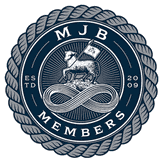2. The Car Coat
You can read an entire history of 20th century menswear in the car coat. It's short, loose-fitting, and has no-fuss Prussian collars that go with nearly everything. For the man who demands style and comfort, the car coat is his indispensable ally.
The modern car coat owes its identity to two related garments: the Scottish Balmacaan and the Duster Coat.
The Balmacaan (named after an estate near Inverness, Scotland), was perhaps the simplest coat a tailor could make. It was single-breasted, pearshaped, had round collars, and was made of thick wool or tightly woven gabardine (similar to the English mac). Practical and straightforward, the Balmacaan was the sort of coat a Scottish farmer might've worn for a twilight trip into town.
The Duster coat, on the other hand, was meant to protect riders on horseback. It was a sturdy coat that fit loosely over the body and protected the wearer from dust and rain. Crafted from oilcloth and later waxed cotton, this rugged coat could endure the wildest conditions (if not necesarily the demise of horse-drawn transport).
These two garments, and the automobile roaring its way into the 20th Century, spurred manufacturers to experiment with new forms of clothing (lest they be swept into the dust bin of history).
One of these forms was the original car coat, which took inspiration from the Balmacaan and the Duster. As its name suggests, the car coat protected those privileged enough to own a private motor vehicle (largely open top at the time). It was practical and took into consideration the realities of riding in a car; hence its short length, as well as the exhibitionism of the leisure classes, hence its handsome, slimmer, sporty design. Attention-seekers, i.e the heirs of oil tycoons, wore fancier versions to flaunt their wealth. Eyeing one blaze down the street in a car coat made of luxurious lamb shearling, racoon fur, or ostritch leather, upset both sense and sensibility.
Like most things during the 20th Century, it didn't take long for the car coat to take on a radically different form. By the mid-60s the car coat had evolved into the "driving-mac" most of us are familiar with today. The driving mac had set-in sleeves, rounded collars, a fly-front closure and slanted hip pockets that retained the spirit of the original car coat without any of the cultural baggage. Modern textiles also made the coat lighter, and its widespread adoption by the middle class forced it into sobriety.
In Spring or Autumn, the car coat is ubiquitous and for good reasons. It's light and unstructured, meaning you can wear it with jeans and a t-shirt; it's dressier than a military style-inspired jacket so you can wear it with a suit or blazer, and it's sophisticated enough to throw over pretty much anything and still look good. Regardless of your fortune, every man can appreciate a car coat.



